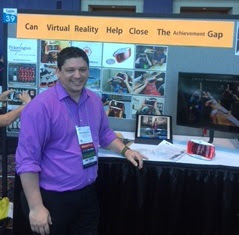"Can
virtual-reality help close the achievement gap?" For those not fluent in
this topic, in the United States the "achievement gap" signifies the
persistent gap we see in the academic performance levels of students of
differing social economic status, race/ethnicity, and gender. In U.S. schools,
the efforts to shrink this gap are relentless.
Brian Seymour, Director of Instructional Technology with
the Pickerington Local School District Ohio, campaigns passionately about
reducing some of these disparities with the help of virtual reality. Seymour, named the Ohio IT IP Outstanding Technology Using Administrator for 2017,
laments that “educators around the world are looking for ways to close the
achievement gap that exists between privileged students in disadvantaged
students” and has acted on the hunch that “virtual-reality [could do] a fantastic
job of allowing students to have virtual experiences that they might not have
otherwise.” This is his story, his case study.
Background
Seymour began by
rolling out a two-part case study on using VR to reduce the achievement gap at
Tussing Elementary, a diverse school where 58% of students receive free or
reduced lunch and more than 25 languages are spoken at home. The plan was to
use VR within a three-week unit on oceans and marine animals. “For students in Ohio, going to the beach is
no easy outing”, he explained. “Those with means can fly to the East or West
Coast during summer vacation. But many will never see the ocean up close." The lack of ocean experience for these landlocked students would ordinarily “leave students disengaged with
the material.” With VR, however, they hoped to take students on a field trip to
the beach, try a bit of snorkeling, and experience the inside of a shark cage.
Procedures
Using Viewmaster VR
goggles, purchased in four classroom sets (28 goggles per set, at roughly $7000 per kit), a
core group of educators first learned how to use them and then matched up the
best content possible in order to meet their unit learning objectives.
At first, students
were taught traditionally for two weeks. When the first day of VR instruction
arrived, the goggles were set up in the classroom while the kids were at lunch,
and the app was loaded, and launched for use. The kids returned from lunch and
recess and, after just 3 minutes of how-to instruction, the children were off
exploring the ocean. (Yes, today's students are bright, able to learn what they need to know and proceed on
their own in minutes.)
Three adults facilitated
the learning in the room, ensuring that students stay in their seats and not
bump into each other. These educators also circulated around the room, asking
questions and reminding the children kids to explore in all directions, not
just what was in front of them.
In a second
experience, the educators pursued a blended learning approach, having half of
the students on the VR goggles, while the remaining children read a story
related to their VR experience and then switched. This technique had only half of the students
on the VR goggles at any one time. (Note that these classroom sets are a shared
resource, travelling around the district.)
What were the results? Come back next week for the interesting findings...

No comments:
Post a Comment